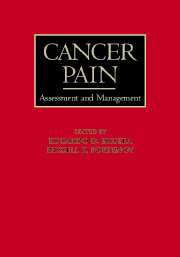Book contents
- Frontmatter
- Contents
- List of contributors
- Preface
- SECTION I MECHANISMS AND EPIDEMIOLOGY
- SECTION II ASSESSMENT AND SYNDROMES
- SECTION III PHARMACOLOGICAL TREATMENT
- 7 Pharmacology of analgesia: basic principles
- 8 Pharmacology of opioid analgesia: clinical principles
- 9 Opioid side effects and management
- 10 Nonopioid analgesics
- 11 Adjuvant analgesic drugs
- SECTION IV NONPHARMACOLOGICAL APPROACHES
- SECTION V THE ROLE OF ANTINEOPLASTIC THERAPIES IN PAIN CONTROL
- SECTION VI PAIN IN SPECIAL POPULATIONS
- SECTION VII DIFFICULT PAIN PROBLEMS
- SECTION VIII SPECIAL TOPICS
- Index
7 - Pharmacology of analgesia: basic principles
from SECTION III - PHARMACOLOGICAL TREATMENT
Published online by Cambridge University Press: 08 October 2009
- Frontmatter
- Contents
- List of contributors
- Preface
- SECTION I MECHANISMS AND EPIDEMIOLOGY
- SECTION II ASSESSMENT AND SYNDROMES
- SECTION III PHARMACOLOGICAL TREATMENT
- 7 Pharmacology of analgesia: basic principles
- 8 Pharmacology of opioid analgesia: clinical principles
- 9 Opioid side effects and management
- 10 Nonopioid analgesics
- 11 Adjuvant analgesic drugs
- SECTION IV NONPHARMACOLOGICAL APPROACHES
- SECTION V THE ROLE OF ANTINEOPLASTIC THERAPIES IN PAIN CONTROL
- SECTION VI PAIN IN SPECIAL POPULATIONS
- SECTION VII DIFFICULT PAIN PROBLEMS
- SECTION VIII SPECIAL TOPICS
- Index
Summary
Introduction
Opioid analgesic drugs are commonly prescribed for the management of pain resulting from cancer. During the last 20 years there has been a dramatic increase in our knowledge of the sites and mechanisms of action of opioids (1). The development of analytical methods has also been of great importance by facilitating pharmacokinetic studies of the disposition and fate of opioids in patients. These studies have begun to offer us a better understanding of some of the sources of interindividual variation in the response to opioids and to suggest ways to minimize some of their adverse effects (2,3). Although there are gaps in our knowledge of opioid pharmacology, the rational and appropriate use of these drugs is based on the knowledge of their pharmacological properties derived from well-controlled clinical trials (4).
Individualized dosage
The fundamental concept that underlies the appropriate and successful management of cancer pain by the use of opioid and non-opioid analgesics is individualization of analgesic therapy (4,5). This concept entails selection of the right analgesic, administered in the right dose and on the right schedule so as to maximize pain relief and minimize adverse effects (4–6). This comprehensive approach begins with the non-opioids or mild analgesics for mild pain (see Chapter 10). In patients with moderate pain that is not controlled by non-opioids alone, the so-called weak opioids alone or in combination should be prescribed. In patients with severe pain, a strong opioid is the drug of choice given alone or in combination (see Chapter 8). At all levels certain adjuvant drugs are used for specific indications (5–7) (see Chapter 11).
- Type
- Chapter
- Information
- Cancer PainAssessment and Management, pp. 111 - 123Publisher: Cambridge University PressPrint publication year: 2003



